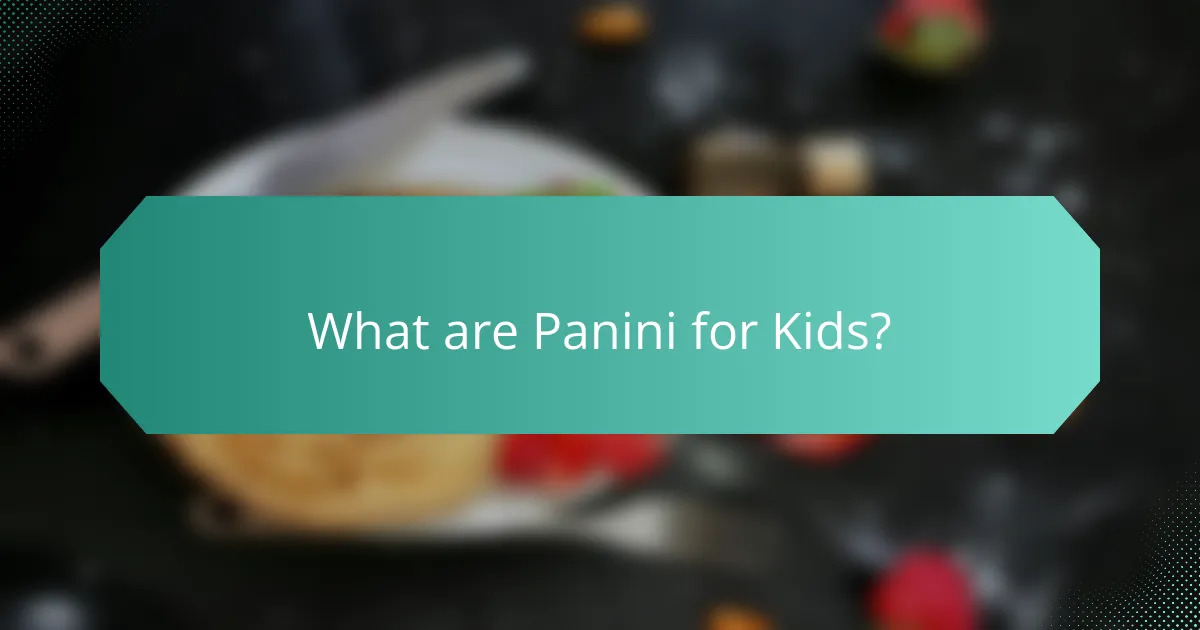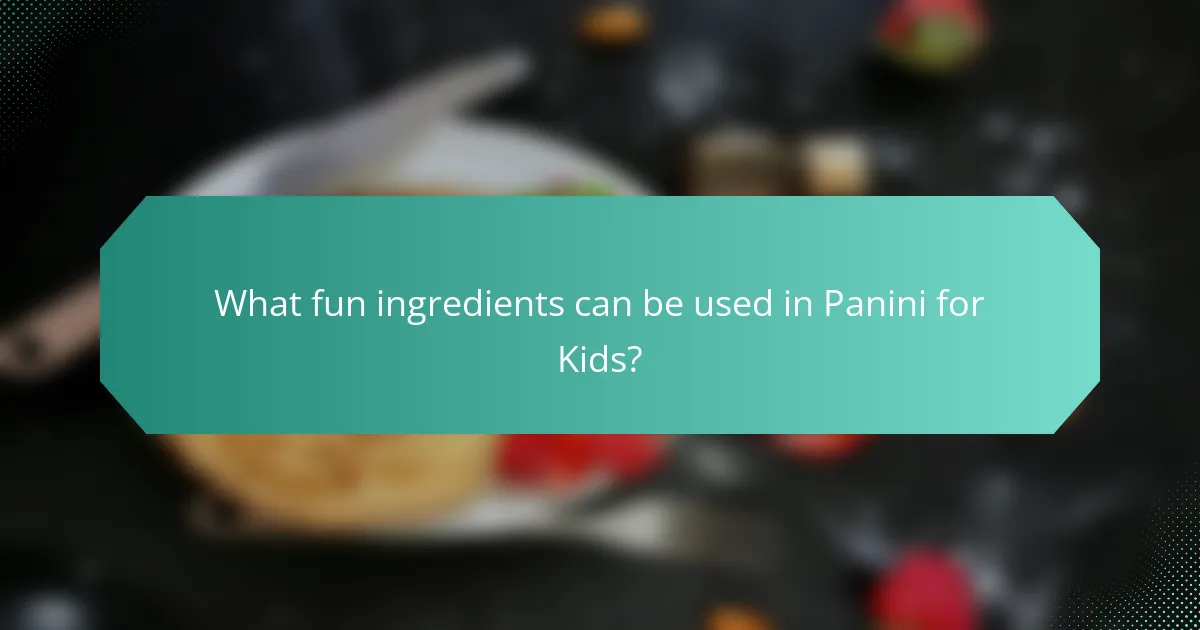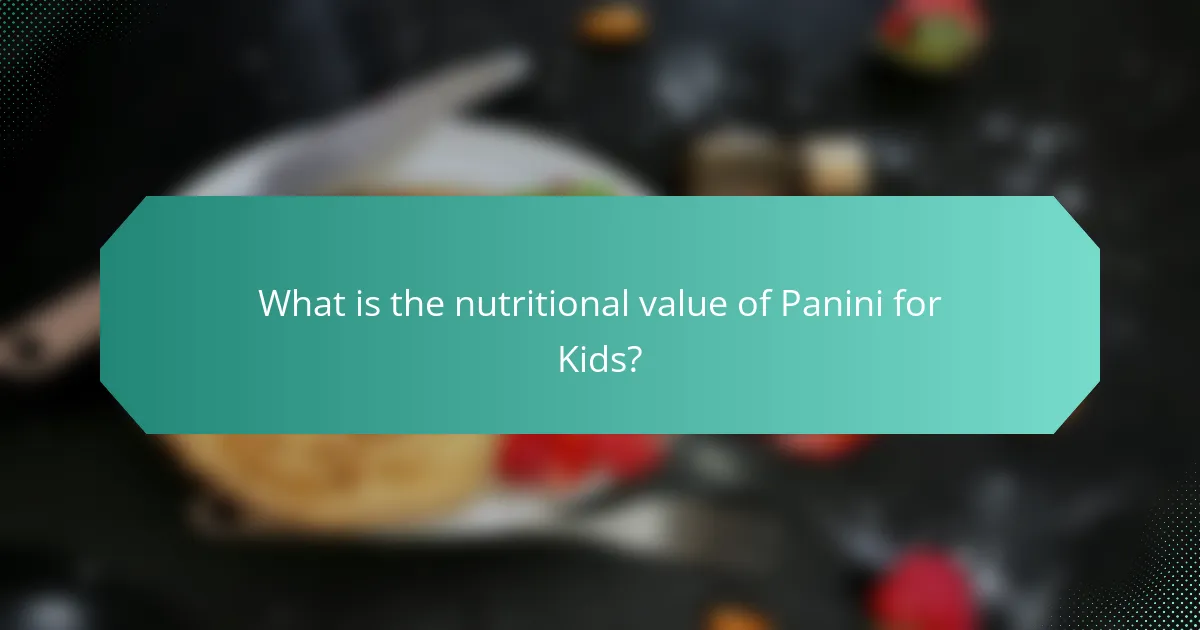
What are Panini for Kids?
Panini for kids are grilled sandwiches made with various fillings. They are typically made from bread like ciabatta or focaccia. Kids enjoy panini because they can be customized with fun ingredients. Common fillings include cheese, meats, and vegetables. The sandwiches are often pressed to create a crispy texture. Panini can also be shaped into fun designs to engage children. They offer nutritional value depending on the ingredients used. Overall, panini for kids are a versatile and appealing meal option.
How are Panini different from other sandwiches?
Panini are different from other sandwiches primarily due to their unique preparation method. They are made using Italian bread, typically ciabatta or focaccia. The bread is pressed and grilled, resulting in a crispy exterior and warm filling. This method distinguishes them from regular sandwiches, which are often assembled without grilling. Additionally, panini are usually filled with a variety of ingredients, such as meats, cheeses, and vegetables. The grilling process melts the cheese and melds the flavors together. This creates a more cohesive taste compared to traditional sandwiches. The name “panini” itself means “small breads” in Italian, emphasizing their specific cultural origin.
What unique features make Panini appealing to kids?
Panini are appealing to kids due to their fun shapes and customizable ingredients. Kids enjoy the interactive aspect of choosing their fillings. The grilled texture offers a satisfying crunch that many children find enjoyable. Bright colors from fresh vegetables make the sandwich visually appealing. Unique shapes, like stars or animals, can make eating more exciting. Additionally, panini can be made with various flavors to cater to different tastes. They can also be a healthier option, providing essential nutrients. Overall, these features combine to create a fun and engaging meal for children.
What types of bread are commonly used for Panini?
Ciabatta and focaccia are commonly used for Panini. Ciabatta is known for its rustic texture and airy crumb. Focaccia offers a slightly thicker and softer option. Other breads include baguette and sourdough. These breads hold up well when pressed. They create a crispy exterior while keeping the filling warm. Each type adds unique flavors and textures to the Panini.
Why are Panini a popular choice for children?
Panini are a popular choice for children due to their customizable nature. Children enjoy selecting their favorite ingredients. This encourages creativity and personal expression in meal preparation. The fun shapes of Panini make them visually appealing to kids. Additionally, Panini can be made with nutritious ingredients, promoting healthy eating. Research shows that children are more likely to eat foods they help create. This combination of factors makes Panini an attractive option for parents and kids alike.
How do Panini cater to kids’ taste preferences?
Panini cater to kids’ taste preferences by offering fun ingredients and creative shapes. Kids often enjoy familiar flavors like cheese and ham. These ingredients are commonly used in Panini to appeal to younger palates. Additionally, colorful vegetables can be included to enhance visual appeal. The use of playful shapes makes the meal more engaging for children. Mini Panini sizes are also designed to be manageable for small hands. Customization options allow kids to choose their favorite fillings. This interactive element encourages kids to explore different flavors while enjoying their meal.
What role do visuals play in attracting kids to Panini?
Visuals play a crucial role in attracting kids to Panini. Bright colors and fun shapes appeal to children’s preferences. Engaging images of Panini can stimulate interest and excitement. Visual presentation influences kids’ perceptions of taste and enjoyment. Studies show that colorful food can increase children’s willingness to try new items. For example, a study published in the Journal of Nutrition Education and Behavior found that visually appealing meals encourage children to eat healthier. Therefore, effective visuals enhance the overall appeal of Panini for kids.

What fun ingredients can be used in Panini for Kids?
Fun ingredients for kids’ Panini include colorful vegetables, different cheeses, and unique spreads. Bell peppers, cucumbers, and spinach add vibrant colors and crunch. Cheeses like mozzarella, cheddar, and cream cheese provide creamy textures. Spreads such as hummus, pesto, and apple butter introduce exciting flavors. Additionally, kids enjoy ingredients like turkey, ham, and pepperoni for protein. Sweet options like Nutella or fruit preserves can create a dessert Panini. These ingredients not only make the Panini visually appealing but also enhance the taste experience for children.
How can parents choose healthy ingredients for Panini?
Parents can choose healthy ingredients for Panini by focusing on whole, minimally processed foods. Select whole grain bread for added fiber and nutrients. Incorporate lean proteins like turkey, chicken, or plant-based options such as hummus. Include a variety of colorful vegetables like spinach, bell peppers, and tomatoes for vitamins and minerals. Opt for low-fat cheese or dairy alternatives to reduce saturated fat intake. Choose healthy spreads like avocado or pesto instead of mayonnaise. Limit high-sodium ingredients such as processed meats and cheeses. Aim for balance by combining proteins, healthy fats, and carbohydrates in each Panini. These choices promote better nutrition for children while enhancing flavor and enjoyment.
What are some nutritious fillings that kids enjoy?
Nutritious fillings that kids enjoy include turkey and cheese, hummus with veggies, and peanut butter with banana. Turkey and cheese provide protein and calcium, essential for growing bodies. Hummus offers fiber and vitamins, making it a healthy choice. Peanut butter contains healthy fats and protein, while bananas add potassium and natural sweetness. These combinations are appealing and nutritious, making them popular among children.
How can creative toppings enhance the flavor of Panini?
Creative toppings can significantly enhance the flavor of Panini. They introduce diverse tastes and textures. For example, adding roasted vegetables can provide sweetness and earthiness. Spicy sauces can add heat and complexity. Fresh herbs like basil or arugula contribute brightness and freshness. Unique cheeses, such as goat or blue cheese, can create rich, tangy flavors. These toppings can transform a simple sandwich into a gourmet experience. A study shows that variety in toppings can increase overall satisfaction in meals. This highlights the importance of creativity in enhancing flavor profiles.
What are some kid-friendly combinations for Panini?
Kid-friendly combinations for Panini include grilled cheese with tomatoes, turkey and cheese with spinach, and peanut butter with banana. Grilled cheese is simple and popular among children. Turkey and cheese provide protein and can be enhanced with spinach for added nutrition. Peanut butter and banana offer a sweet and healthy option that kids enjoy. These combinations are easy to prepare and cater to children’s tastes.
Which ingredient pairings are most popular among kids?
Cheese and ham are among the most popular ingredient pairings for kids. Many children enjoy the melty texture of cheese combined with the savory flavor of ham. Another favorite is peanut butter and jelly, which offers a sweet and creamy combination. Kids also love the classic pairing of turkey and cheese in sandwiches. Additionally, combinations like tomato and mozzarella are favored for their simple and fresh taste. These pairings are commonly found in school lunches and family meals. They appeal to children’s taste preferences and are easy to prepare.
How can parents involve kids in choosing their Panini ingredients?
Parents can involve kids in choosing their Panini ingredients by encouraging them to select their favorite toppings. This can include meats, cheeses, and vegetables. Parents can create a list of options for kids to choose from. They can also take kids grocery shopping to pick out ingredients together. Engaging kids in the process fosters their interest in food. It helps them learn about nutrition and variety. Additionally, parents can allow kids to suggest unique combinations. This encourages creativity and personal preference in meal preparation.

What creative shapes can Panini take?
Panini can take various creative shapes, enhancing their appeal to kids. Common shapes include triangles, rectangles, and circles. Some panini are made into fun animal shapes using cookie cutters. Others are pressed into star or heart shapes for special occasions. Additionally, panini can be folded or rolled for unique presentations. Using different bread types allows for more shape variations. Creative shapes can make mealtime more engaging for children. These fun shapes can encourage kids to try new ingredients and flavors.
How do shapes influence kids’ willingness to eat Panini?
Shapes significantly influence kids’ willingness to eat Panini. Children are naturally drawn to visually appealing food. Fun shapes can make Panini more exciting and engaging. Research shows that food presentation affects children’s eating behavior. For instance, a study published in “Appetite” found that children are more likely to try foods that are presented in fun shapes. Creative shapes can stimulate curiosity and encourage kids to explore new flavors. Overall, appealing shapes can enhance children’s interest in Panini, leading to increased consumption.
What tools can be used to create fun shapes for Panini?
Cookie cutters can be used to create fun shapes for Panini. These tools come in various designs, including animals and stars. They allow for easy cutting of bread or fillings into playful shapes. A sandwich press can also shape Panini while grilling them. This tool ensures that the edges are sealed and the shape is maintained. Additionally, a sharp knife can be used for freehand cutting. This method allows for custom shapes based on creativity. Each tool enhances the visual appeal of the Panini, making them more attractive to kids.
How can themed shapes make meals more exciting for kids?
Themed shapes can make meals more exciting for kids by enhancing visual appeal and engagement. Fun shapes can stimulate children’s imagination and curiosity. When meals look playful, kids are more likely to try new foods. Research shows that visually appealing food increases children’s willingness to eat. For example, a study published in the journal Appetite found that children preferred food presented in fun shapes over standard presentations. Themed shapes can also encourage creativity during meal preparation. Engaging kids in the cooking process can foster a positive attitude towards healthy eating.
What are some examples of creative Panini shapes?
Some examples of creative Panini shapes include stars, hearts, and animals. These shapes can be achieved using cookie cutters or by carefully cutting the bread. Star-shaped Paninis can be filled with cheese and ham. Heart-shaped Paninis are often made with nut butter and jelly. Animal-shaped Paninis can feature various fillings like turkey and cheese. These creative shapes make Paninis visually appealing for kids. Engaging shapes can encourage children to eat more nutritious ingredients.
How can seasonal shapes be incorporated into Panini making?
Seasonal shapes can be incorporated into Panini making by using cookie cutters to create fun designs. For example, during Halloween, pumpkin or ghost shapes can be cut from the bread. In winter, snowflake shapes can add a festive touch. Using seasonal ingredients can also enhance the theme. For instance, adding pumpkin puree or cranberry sauce in fall creates a seasonal flavor profile. These techniques engage children and make meals more visually appealing. Studies show that children are more likely to eat foods that are fun and visually attractive.
What are some tips for presenting Panini in fun ways?
To present Panini in fun ways, use creative shapes and colorful ingredients. Cut Panini into fun shapes using cookie cutters. This engages kids and makes eating more enjoyable. Add vibrant vegetables like bell peppers and spinach for visual appeal. Use different breads, such as whole grain or ciabatta, to vary textures. Create a DIY Panini station where kids can customize their fillings. Incorporate dips like marinara or pesto to enhance flavor. Arrange Panini on colorful plates or skewers for a playful presentation. These methods make mealtime exciting and encourage kids to try new combinations.

What is the nutritional value of Panini for Kids?
Panini for kids typically contains various nutritional components. A standard panini may provide around 250-400 calories. It often includes 10-20 grams of protein, depending on the filling. The carbohydrate content usually ranges from 30-50 grams. Dietary fiber can be about 2-5 grams. Additionally, it may contain 5-15 grams of fat. The nutritional value varies based on ingredients and portion sizes. Whole grain bread increases fiber content. Lean meats and vegetables enhance protein and vitamins.
How can Panini contribute to a balanced diet for children?
Panini can contribute to a balanced diet for children by incorporating various nutritious ingredients. Whole grain bread used in panini provides essential fiber for digestion. Lean proteins, such as turkey or chicken, offer necessary amino acids for growth. Adding vegetables like spinach or bell peppers enhances vitamins and minerals intake. Cheese can provide calcium for strong bones. When prepared with healthy fats, such as avocado, panini can support brain development. The combination of these ingredients allows for a well-rounded meal option. Moreover, panini can be customized to meet dietary needs, making them versatile for children’s preferences.
What essential nutrients can be included in Panini?
Panini can include essential nutrients such as protein, fiber, vitamins, and minerals. Protein sources can come from meats, cheeses, or legumes. Fiber can be added through whole grain bread and vegetables. Vitamins A, C, and K are found in leafy greens and colorful vegetables. Minerals like calcium and iron can come from cheese and meats. These nutrients contribute to a balanced diet and support overall health.
How can parents ensure that Panini are both tasty and nutritious?
Parents can ensure that Panini are both tasty and nutritious by selecting high-quality ingredients. Whole grain bread is a healthier option compared to white bread. Parents can include lean proteins like turkey, chicken, or hummus for added nutrition. Fresh vegetables such as spinach, tomatoes, and bell peppers enhance flavor and health benefits. Using low-fat cheeses provides a creamy texture while reducing fat content. Parents should also limit high-calorie sauces and opt for healthier alternatives like avocado or pesto. Preparing Panini at home allows for control over portion sizes and ingredient quality. Studies show that homemade meals can be more nutritious than restaurant options.
What are some common misconceptions about Panini nutrition?
Common misconceptions about Panini nutrition include the belief that they are inherently unhealthy. Many think Panini are always high in calories and fat due to their bread and filling. However, the nutritional value of a Panini depends on its ingredients. Using whole grain bread and fresh vegetables can create a nutritious meal. Another misconception is that all Panini are processed. Many can be made with fresh, whole ingredients, avoiding additives. Additionally, some believe Panini lack variety. In reality, they can include diverse fillings like lean proteins and various vegetables, offering balanced nutrition.
How does the preparation method affect the nutritional value of Panini?
The preparation method significantly impacts the nutritional value of Panini. Grilling Panini can enhance the flavor while retaining nutrients. However, excessive heat may lead to nutrient loss, particularly in vegetables. Toasting bread increases caloric density but can also create a crunchier texture. Using healthier oils for grilling can add beneficial fats. Conversely, frying Panini can elevate unhealthy fat content. The choice of ingredients also plays a crucial role in overall nutrition. For example, whole grain bread offers more fiber than white bread. Thus, preparation methods and ingredient choices together determine the nutritional profile of Panini.
What are some tips for making healthy Panini for Kids?
Use whole grain bread for healthier Panini. Whole grain bread contains more fiber than white bread. Incorporate lean proteins like turkey or chicken. Lean proteins support muscle growth and are lower in fat. Add plenty of vegetables such as spinach, tomatoes, or bell peppers. Vegetables provide essential vitamins and minerals. Use low-fat cheese options to reduce saturated fat. Low-fat cheese still provides calcium without excess calories. Limit sauces and spreads high in sugar or fat. Opt for mustard or hummus instead for added flavor. Grill or toast the Panini for a crispy texture. Cooking enhances the flavors and makes it more appealing to kids.
Panini for kids are customizable grilled sandwiches made from Italian bread like ciabatta or focaccia, featuring various fillings such as cheese, meats, and vegetables. This article explores the unique characteristics that differentiate panini from traditional sandwiches, highlighting their fun shapes and interactive nature that appeal to children. It also discusses the nutritional value of panini, emphasizing healthy ingredient choices and creative combinations that cater to kids’ taste preferences. Additionally, the article examines how presentation and preparation methods can enhance the overall appeal and enjoyment of panini for young eaters.